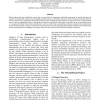Free Online Productivity Tools
i2Speak
i2Symbol
i2OCR
iTex2Img
iWeb2Print
iWeb2Shot
i2Type
iPdf2Split
iPdf2Merge
i2Bopomofo
i2Arabic
i2Style
i2Image
i2PDF
iLatex2Rtf
Sci2ools
LREC
2008
2008
A Common Ground for Virtual Humans: Using an Ontology in a Natural Language Oriented Virtual Human Architecture
When dealing with large, distributed systems that use state-of-the-art components, individual components are usually developed in parallel. As development continues, the decoupling invariably leads to a mismatch between how these components internally represent concepts and how they communicate these representations to other components: representations can get out of synch, contain localized errors, or become manageable only by a small group of experts for each module. In this paper, we describe the use of an ontology as part of a complex distributed virtual human architecture in order to enable better communication between modules while improving the overall flexibility needed to change or extend the system. We focus on the natural language understanding capabilities of this architecture and the relationship between language and concepts within the entire system in general and the ontology in particular.
Contain Localized Errors | Education | Individual Components | LREC 2008 | State-of-the-art Components |
| Added | 29 Oct 2010 |
| Updated | 29 Oct 2010 |
| Type | Conference |
| Year | 2008 |
| Where | LREC |
| Authors | Arno Hartholt, Thomas Russ, David R. Traum, Eduard H. Hovy, Susan Robinson |
Comments (0)

